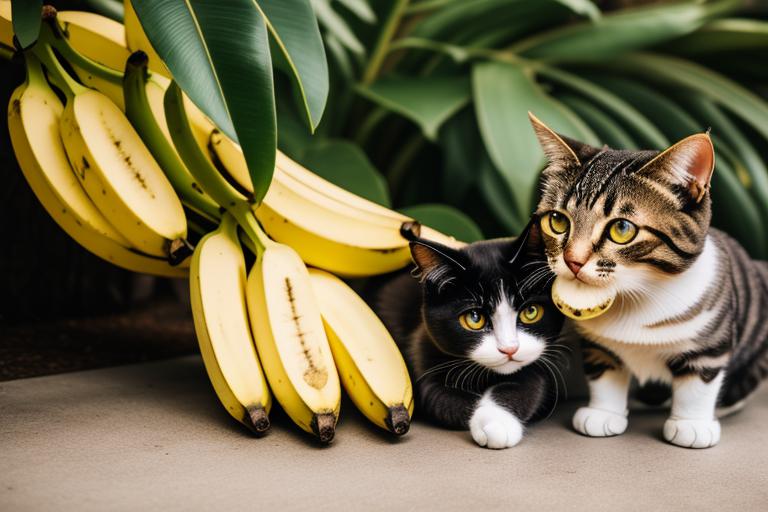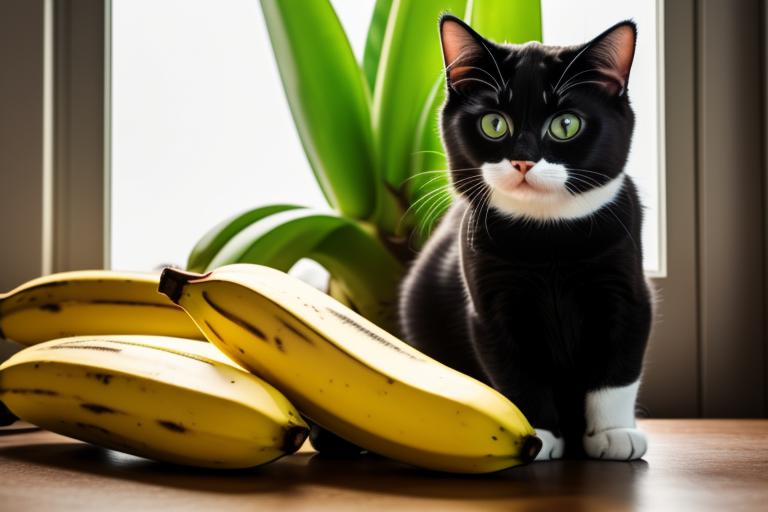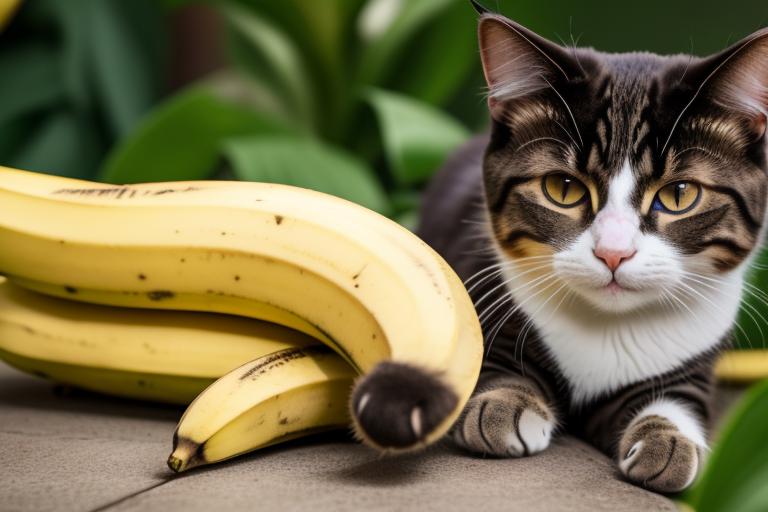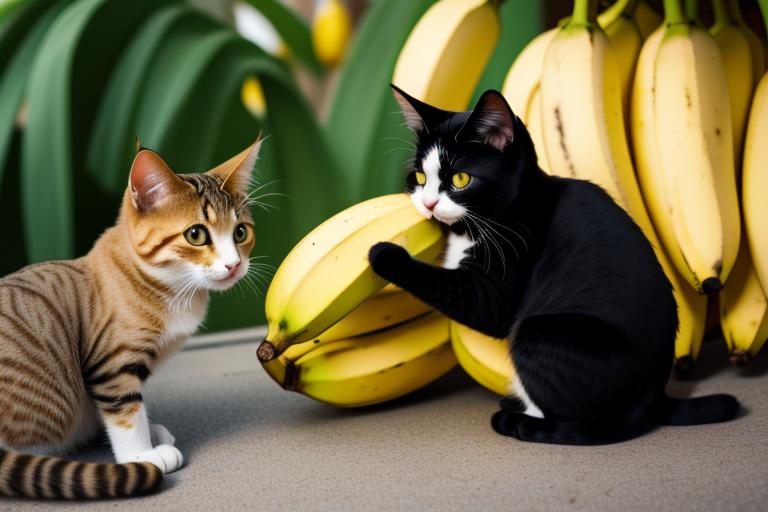Did you know that bananas are the most popular fruit in the world, with over 100 billion bananas consumed annually?
But when it comes to cats, can they also enjoy this tropical treat? You might be curious about whether it’s safe to share your bananas with your feline friend.
Well, the answer isn’t as straightforward as you might think. While bananas can offer some nutritional benefits, there are potential risks to consider as well.
So, if you’re eager to learn more about whether cats can eat bananas and how to do it safely, keep reading to discover all the important details.
Nutritional Value of Bananas for Cats

Cats can safely eat bananas as an occasional treat due to their moderate nutritional value. While bananas may not be a necessary part of a cat’s diet, they can provide some beneficial nutrients.
Bananas are a good source of potassium, which helps maintain proper heart and muscle function in cats. They also contain vitamin C, which supports the immune system and promotes overall health. Additionally, bananas are a source of dietary fiber, which can aid in digestion and prevent constipation in cats.
However, it’s important to remember that bananas should only be given in small amounts as a treat. Feeding your cat too many bananas can lead to an upset stomach or diarrhea due to their high sugar content. It’s also important to remove the banana peel before offering it to your cat, as it can be difficult for them to digest.
Potential Risks of Feeding Bananas to Cats

Feeding bananas to your feline friend may pose potential risks that you should be aware of. While bananas are generally safe for cats to consume in small amounts, there are a few things you should keep in mind:
- Digestive Issues: Cats have a sensitive digestive system, and feeding them too much banana can lead to gastrointestinal upset. This may manifest as diarrhea or vomiting, causing discomfort for your furry friend.
- High Sugar Content: Bananas are naturally sweet and contain a high amount of sugar. Feeding your cat too many bananas can lead to weight gain and potential health issues such as diabetes. It’s important to remember that cats have different dietary needs than humans.
- Allergic Reactions: Just like humans, cats can have allergies too. Some cats may be allergic to bananas, and feeding them this fruit can cause symptoms such as itching, sneezing, or even difficulty breathing. If you notice any signs of an allergic reaction, it’s best to consult your veterinarian.
- Choking Hazard: Cats have small mouths and may have difficulty chewing large chunks of banana. This can increase the risk of choking, especially if the banana isn’t cut into small, manageable pieces.
To ensure the safety of your cat, it’s always a good idea to consult with your veterinarian before introducing any new foods into their diet.
How to Introduce Bananas to Your Cat

To safely introduce bananas to your furry friend, it’s important to follow a gradual and controlled approach. Start by offering a small piece of banana to your cat as a treat. Watch closely for any signs of adverse reactions such as vomiting or diarrhea. If your cat shows no negative response, you can continue to offer small amounts of banana as an occasional treat.
Remember to always peel the banana and remove any seeds before giving it to your cat. The peel and seeds can be difficult for cats to digest and may cause gastrointestinal issues. Additionally, make sure that the banana is ripe and not overripe, as overly ripe bananas can be a choking hazard for cats.
It’s also essential to monitor your cat’s overall diet and ensure that bananas are given in moderation. While bananas can provide some nutritional benefits, such as potassium and vitamins, they shouldn’t replace a balanced and species-appropriate diet. Too much banana can lead to an upset stomach or weight gain.
If you have any concerns or if your cat has specific dietary restrictions, it’s always best to consult with your veterinarian before introducing bananas or any new food into their diet.
Signs of Allergic Reactions in Cats
After introducing bananas to your cat, it’s important to be aware of the signs that may indicate an allergic reaction. Allergies in cats can manifest in various ways, and identifying these signs early on can help you take appropriate action. Here are four key signs to watch out for:
- Itching and scratching: If your cat starts excessively scratching or licking itself after consuming bananas, it could be a sign of an allergic reaction. Pay close attention to any changes in their grooming behavior.
- Digestive issues: Cats with banana allergies may experience vomiting, diarrhea, or stomach upset. Keep an eye out for any sudden changes in their litter box habits or unusual bowel movements.
- Skin problems: Allergic reactions can cause skin irritations such as redness, swelling, or hives. Monitor your cat for any rashes or lesions, particularly around the face, paws, or belly.
- Respiratory distress: Wheezing, coughing, or difficulty breathing are serious signs of an allergic reaction. If your cat shows any of these symptoms, seek immediate veterinary attention.
Alternatives to Bananas for Cat Treats
If your cat can’t have bananas, there are several alternatives for cat treats that you can consider.
One option is to offer your cat small pieces of cooked chicken or turkey. These lean meats aren’t only tasty but also provide essential protein for your feline friend.
Another alternative is to give your cat small amounts of plain yogurt. Not only does yogurt provide a good source of calcium, but it also contains probiotics that can help with digestion. Just make sure to choose yogurt that doesn’t contain any added sugars or artificial flavors.
Additionally, you can try giving your cat small pieces of cooked fish, such as salmon or tuna. Fish isn’t only a great source of protein but also contains omega-3 fatty acids that are beneficial for your cat’s skin and coat.
Lastly, you can consider offering your cat small amounts of cooked vegetables like carrots or peas. These can be a healthy and low-calorie option for your cat’s treats. Remember to introduce any new food gradually and monitor your cat’s reaction to ensure they tolerate it well.
Frequently Asked Questions
Bananas may not be the best source of vitamins and minerals for cats. While they contain certain nutrients, cats have specific dietary needs that are better met with a balanced cat food.
Feeding bananas to cats can lead to digestive problems. It’s best to avoid giving them this fruit, as their digestive systems are not designed to process it. Stick to cat-friendly foods instead.
You can safely incorporate bananas into your cat’s diet by introducing small amounts as treats. Remember to remove the peel and mash the banana to avoid any choking hazards. Monitor for any digestive issues.
If your cat has an allergic reaction to bananas, there are a few signs to look out for. These may include vomiting, diarrhea, excessive itching, swelling, and difficulty breathing. It’s best to consult with a veterinarian for proper diagnosis and treatment.
Instead of bananas, you can give your cat alternative treats such as cooked chicken, tuna, or cat-friendly fruits like watermelon or cantaloupe. These options can be healthier and more suitable for your feline friend.
Conclusion
In conclusion, while bananas can be a source of vitamins and minerals for cats, they should be given in moderation.
It’s important to introduce bananas slowly and watch for any signs of allergic reactions.
If you’re unsure about feeding bananas to your cat, there are plenty of alternative cat treats available that are specifically formulated for their nutritional needs.
Always consult with your veterinarian before introducing any new food into your cat’s diet.

